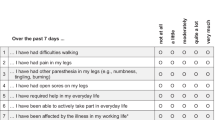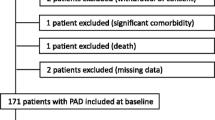Abstract
Quality of Life in Patients with PAOD Treated with Ifenprodil Tartrate: Results of the ARTEMIS Study
A clinical trial was performed to assess the effects on quality of life of a treatment (ifenprodil tartrate 20mg, 3 times daily for one year) in patients suffering from peripheral arterial obliterative disease of the lower extremities with intermittent claudication. A specific questionnaire — ARTEMIS - was used to evaluate quality of life. The study enabled the responsiveness over time of the ARTEMIS questionnaire to be checked.
During this open, prospective, multicentre study, patients requiring treatment for peripheral arterial disease of the lower extremities and recruited by an-giologists and general practitioners filled in the complete or short form of the ARTEMIS questionnaire, respectively, at baseline, and at 3, 6, 9 and 12 months. 4821 patients were recruited. 4494 questionnaires were analysed (169 from the angiologist group and 4325 from the general practitioner group). The majority of the patients (mean age 67 years) were men (70%), either former or current smokers (68%), with high blood pressure (54%), hyperlipidaemia (48%) and type 2 (non-insulin-dependent) diabetes mellitus (16%), and with a 3-year history of intermittent claudication (±3.5) on average.
Quality-of-life scores improved (as from month 3) between baseline and month 12. This progression was significant for all dimensions of the reduced questionnaire (p ≤ 0.0001) and for 12 of the 15 dimensions of the complete version. These quality-of-life results should be measured against the global clinical improvement, which was rated as good by the investigators (70% of cases). Treatment tolerability was assessed for the 4821 patients recruited and was judged satisfactory. The number and type of serious events and recorded deaths corresponded to events commonly observed in this elderly population. These results show how the ARTEMIS quality-of-life scales can be used in community practice during symptomatic treatment with a vasoactive agent such as ifenprodil, to assess quality-of-life improvements in patients suffering from stage II peripheral arterial disease of the lower extremities.
Résumé
Objectifs:Evaluer la qualité de vie des patients souffrant d’une artériopathie oblitérante des membres inférieurs au stade de la claudication intermittente, en utilisant l’échelle ARTEMIS, au cours d’un traitement par le tartrate d’ifenprodil (3 fois 20 mg/jour) pendant un an. Evaluer la sensibilité dans le temps de l’échelle Qualité de Vie ARTEMIS, dernière étape de sa validation.
Méthodes:Etude prospective, menée en ouvert chez des généralistes et des angiologues incluant des patients justiciables d’un traitement médical de l’artériopathie oblitérante des membres inférieurs. Les patients inclus par les angiologues remplissaient l’échelle complète (64 items explorant 15 dimensions) et ceux inclus par les généralistes remplissaient l’échelle réduite (12 items explorant 4 dimensions) lors de l’inclusion et tous les 3 mois pendant un an.
Résultats:4821 patients ont été recrutés; 4494 questionnaires ont pu être analysés (169 patients inclus par les angiologues et 4325 par les généralistes). L’âge moyen était de 67 ans, 70% étaient des hommes, 54% avaient une hypertension artérielle associée, 48% une hyperlipidémie et 16% un diabète non insulino-dépendant; 68% se déclaraient fumeurs ou anciens fumeurs. L’ancienneté de la claudication intermittente était de 3,6 ans en moyenne (± 3,5). Les scores de qualité de vie se sont améliorés dès le troisième mois entre l’inclusion et la fin de l’étude. Cette évolution des scores était significative pour toutes les dimensions du questionnaire réduit (activité physique, psychisme et vitalité, vie quotidienne, satisfaction: p = 0,0001); elle était également significative pour 12 dimensions sur 15 de l’échelle complète, seules “la santé perçue” et “les limitations dues à l’état psychique” n’étant pas améliorées de façon significative. Ces résultats sur la qualité de vie sont à rapprocher de l’amélioration clinique globale, jugée bonne dans 70% des cas par les médecins investigateurs. Evaluée sur les 4821 patients inclus, la tolérance générale du traitement a été satisfaisante. Le nombre et le type d’événements graves et de décès déclarés est conforme à ce que l’on peut voir dans cette population âgée.
Conclusion:Ces résultats attestent de la capacité des échelles de Qualité de Vie ARTEMIS à rendre compte en pratique de ville de l’amélioration de la qualité de vie des patients atteints d’artériopathie oblitérante des membres inférieurs au stade II, lors d’un traitement symptomatique par un vasoactif tel que l’ifenprodil.
Similar content being viewed by others
Références
The European Agency for the Evaluation of Medicinal Products. Note for guidance on the clinical investigation of medicinal products in the treatment of chronic peripheral arterial disease. Brussels: CPMP/EWP, 1995; 233: 11–9
Fletcher A, Gore S, Jones D, et al. Quality of life measures in health care. Design, analysis and interpretation. BMJ 1992; 305: 1145–8
Erickson P, Scott J. The on-line guide to quality-of-life assessment (OLGA): resource for selecting quality-of-life assessments. In: Walker S, Rosser RM, editors. Quality-of-life assessement: key issues in the 1900s. Dordrecht: Kluwer Academic Publishers, 1993; 13: 221–32
Jenkins CD, Stanton BA, Niemcryk SJ, et al. A scale for the estimation of sleep problems in clinical research. J Clin Epidemiol 1998; 41: 313–21
Martin C, Joyce CRB, Marquis P, et al. Elaboration et validation d’un questionnaire Qualité de Vie dans l’ulcère duodénal. Gastroenterol Clin Biol 1991; 15, 2bis: 108
Schipper H, Clinch J, Powell V. Definitions and conceptual issues. In: Spilker B, editor. Quality of life assessments in clinical trials. New York: Raven Press, 1990; 2: 11–24
Rose G, McCartney P, Reid DD. Self administration of a questionnaire on chest pain and intermittent claudication. Br J Prev SocMed 1977; 31: 42–8
Brazier JE, Harper R, Jones NMB, et al. Validating the SF-36 health survey questionnaire: new outcome measures for primary care. BMJ 1992; 305: 160–4
Marquis P, Fayol C, McCarthy C, et al. Mesure de la Qualité de Vie dans la claudication intermittente. Validation clinique d’un questionnaire. Presse Med 1994; 23(28): 1288–92
Deyo RA, Diehr P, Patrick DL. Reproducibility and responsiveness of health status measures: statistics and strategies for evaluation. Controlled Clin Trials 1991; 12: 142S–158S
Marquis P. Evaluation de l’impact de l’artériopathie oblitérante des membres inférieurs sur la qualité de vie. Drugs 1998; 56 Suppl. 3: 25–35
Stewart AL, Hays R, Ware JE. The MOS Short-Form general health survey. Reliability and validity in a patient population. Med Care 1988; 26: 724–32
McHorney CA, Ware JE, Raczek AE. The MOS 36-item short-form health status survey (SF-36) II. Psychometric and clinical tests of validity in measuring physical and mental health constructs. Med Care 1993; 31(3): 247–63
Ware JE, Sherbourne CA. The MOS 36-item short-form health survey (SF-36). Conceptual framework and item selection. Med Care 1992; 30: 473–83
Sherbourne CD. Pain measures in measuring functioning and well-being: the medical outcomes study approach. Durham and London: Duke University Press, 1992; 13: 220–33
Stewart AL, Hays RD, Ware JE. Health perceptions, energy/fatigue, and health distress measures in measuring functioning and well-being: the medical outcomes study approach. Durham and London: Duke University Press, 1992; 8: 143–72
Vray M, Chwalow J, Charansonney O, et al. National study of obliterative disease of the lower limbs involving general practitioners in France: Artemio study. J Cardiovasc Pharmacol 1995; 25 Suppl. 2: S51–S57
Smith GD, Shipley MJ, Rose G. Intermittent claudication, heart disease risk factors, and mortality. The Whitehall Study. Circulation 1990; 82: 1925–31
Author information
Authors and Affiliations
Rights and permissions
About this article
Cite this article
Marquis, P., Lecasble, M. & Passa, P. Qualité de vie de patients souffrant d’AOMI traités par le tartrate d’ifenprodil. Drugs 56 (Suppl 3), 37–48 (1998). https://doi.org/10.2165/00003495-199856003-00005
Published:
Issue Date:
DOI: https://doi.org/10.2165/00003495-199856003-00005




